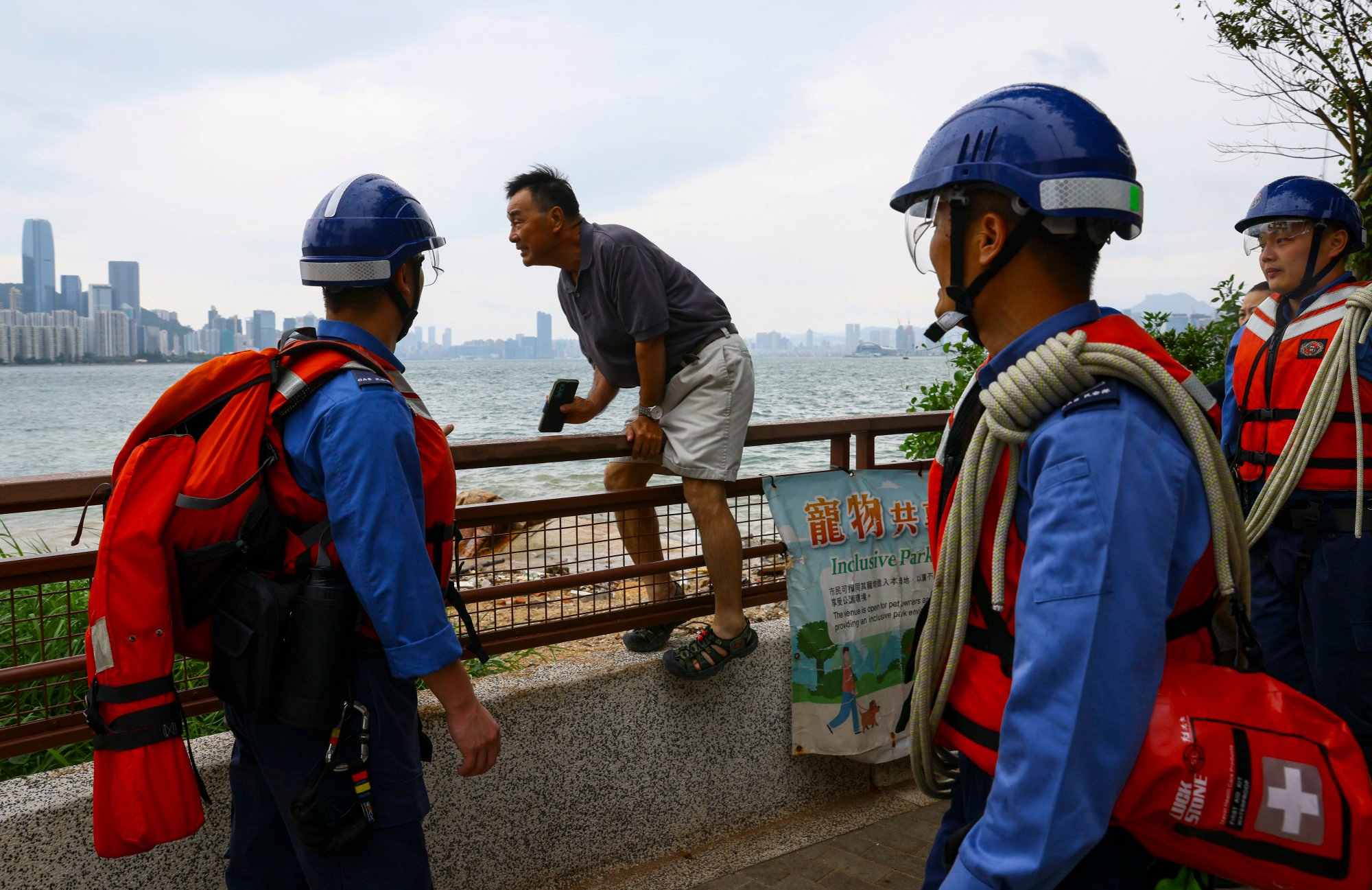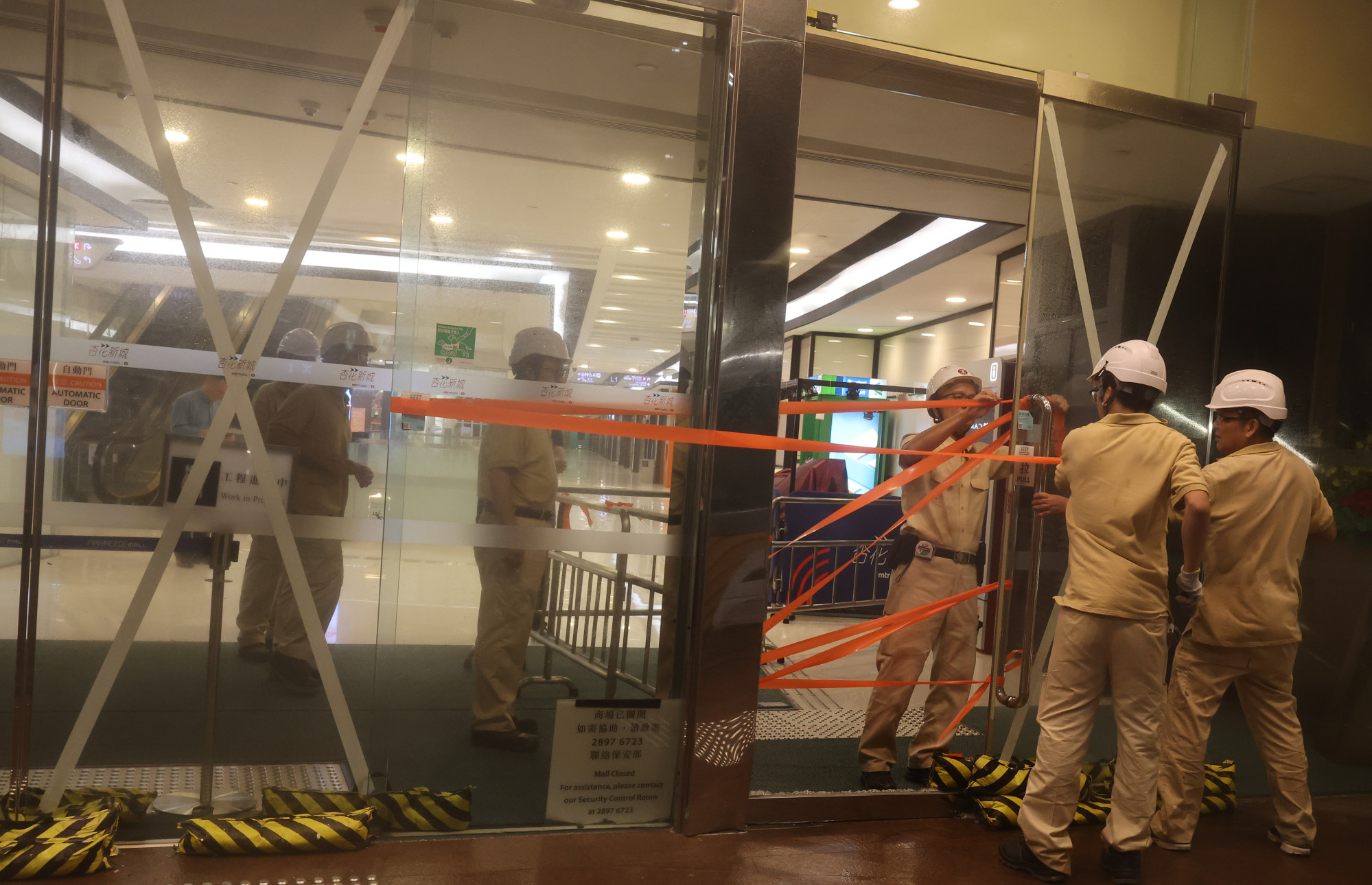
Hong Kong cancels all typhoon warnings after Tropical Storm Saola departs
- Observatory cancels warning at 11.40pm, as local winds continue to weaken
- City had issued maximum No 10 warning signal for first time since Mangkhut hit in 2018
Hong Kong cancelled all typhoon warning signals on Saturday at 11.40 pm as Tropical Storm Saola weakened into a tropical depression..
The Observatory said Saola was gradually departing with local winds continuing to reduce. There will still be swells. Members of the public are advised to stay away from the shoreline, and not to engage in water sports.
The Observatory had issued a No 1 alert at 8.20pm.
At midnight, Saola was centred about 380 kilometres west-southwest of Hong Kong and is forecast to move west-southwest at about 12 kilometres per hour across the coast of western Guangdong and continue to weaken.
Hong Kong experts say Saola’s ‘double eyewall’ typical of very strong storms
The Observatory had issued a landslide warning at 5.50am, with residents advised to keep away from steep slopes or retaining walls. Motorists should avoid driving in hilly areas or on roads with landslip warning signs.
The agency had also issued an amber rainstorm warning at 7.45pm on Friday, signifying flooding was expected in low-lying areas, but it was cancelled at 1am on Saturday.
Residents had been bracing for the arrival of Saola since midweek as the powerful storm edged closer to the city.
The Observatory first issued a No 8 signal early on Friday morning, before raising it to the second-highest level at 6.20pm and upgrading it to No 10 at 8.15pm, marking the first time it was used since Super Typhoon Mangkhut tore through the city in 2018.
The No 10 warning indicates hurricane-force winds with sustained speeds of 118km/h or more. The No 8 signal means wind speeds of 63km/h or above.
Typhoon Saola leaves debris, fallen trees on Hong Kong roads, but impact small
Saola was closest to the city at about 11pm, skirting around 30km to its south.
By 4pm on Saturday, authorities had confirmed 21 cases of flooding and received 1,545 reports of fallen trees. At least 86 people had sought treatment at public hospitals and 520 had taken refuge across 40 temporary shelters set up citywide.
Hong Kong coastal residents in nervous wait over flooding from Super Typhoon Saola
The MTR Corporation said trains would operate at limited frequencies on Saturday, while Citybus, KMB and Long Win Bus suspended most of their daytime routes except for a few with limited levels of service.
The Education Bureau earlier announced all classes would remain suspended on Saturday while the Department of Health said all of its clinics would be closed except for methadone ones.
The Social Welfare Department said all its welfare service units, childcare centres, centres providing after school care programmes, elderly service centres and day rehabilitation units would not open to the public with the No 8 signal up.

The judiciary announced that all hearings of courts and tribunals would be adjourned, while the Hong Kong Examinations and Assessment Authority postponed the chartered financial analyst exam and graduate record examinations set for Saturday morning.
The storm had developed a “double-eyewalled structure”, the Observatory said earlier, referring to the thick circular ring of clouds surrounding the centre, where winds were at their fiercest.
As the eyes interacted, winds could temporarily weaken but grow fiercer if they merged, according to Meteorological Society spokesman Leung Wing-mo.
Flooding could be particularly serious along the eastern coastal areas, especially in Sai Kung, Shing Mun River, Tai Po and Sha Tau Kok, the Observatory said, adding: “The maximum water level may be similar to when Mangkhut hit Hong Kong in 2018.”

The Observatory warned of flooding risks in Pat Heung and Kam Tin, which recorded over 115mm of rain between 6pm and 10pm on Friday.
Water levels at Tolo Harbour were expected to surge four metres above normal to six metres (19 feet) above chart datum, or the original mark, near midnight, exceeding the record of 5.03 metres set under Typhoon Wanda in 1962.
The water level at Tai Po reached around four metres above chart datum after midnight, while at Tai O and Tsim Bei Tsui it is expected to rise to three metres above chart datum between 9am and noon on Saturday.

Around midnight on Friday, the water at Sai Kung was more than four metres above chart datum, while serious flooding was expected in low-lying coastal areas such as Sha Tin, Tai Po, Sha Tau Kok and Sai Kung.
The maximum level at Victoria Harbour is forecast to be three metres above chart datum.
The government activated its flood alert system and an emergency centre for the fishing village of Tai O on Lantau Island, warning sea levels could rise to 3.5 metres above chart datum on Saturday morning.
The area could be hit with serious flooding and residents living in low-lying areas should take shelter as soon as possible, it warned. Flood warnings were also issued for the northern New Territories.

Stock market operator Hong Kong Exchanges and Clearing cancelled all trading on Friday.
The Airport Authority said about 460 flights were cancelled on Friday, and that flight resumption on Saturday remained “uncertain”.
All but one flight operated by Hong Kong’s flag carrier Cathay Pacific Airways to and from the city between 2pm on Friday and 10am on Saturday had been cancelled. The airline also issued warnings about additional delays and cancellations.
The Hong Kong-Zhuhai-Macau Bridge was closed at 3.30pm, according to the Transport Department, while all high-speed rail link services between Hong Kong West Kowloon station and mainland China were cancelled until at least Saturday.
Hundreds stranded at Hong Kong airport after carriers cancel 460 flights
Transport services were either suspended or severely curtailed. While the MTR Corporation continued to offer its underground service, trains operating in exposed areas, such as the Airport Express, stopped running when the No 9 signal went up at 6.20pm.
All routes operated by KMB, Citybus and Long Win Bus were suspended, and ferry services between Hong Kong Island and outlying ones, as well as Macau, were halted.
Bus services to and from the city’s border control points were also suspended.
All general and specialist outpatient clinics, allied health and other day services under the Hospital Authority were closed, but public accident and emergency departments remained open.

Former Observatory chiefs warned residents to beware of the impact of Saola, named after a rare horned mammal in Vietnam. Lam Chiu-ying, who stepped down as director in 2009, urged people to up preparations on Friday morning.
“Can you see the trend for how the typhoon is moving? Brace for the worst, and make your best preparations,” Lam said.
Former director Shun Chi-ming advised people to stay indoors, warning that Saola could besiege the city.
Ex-assistant director Leung Wing-mo warned on Friday that the impact of Saola would be “significant” if it hit the city directly, saying the fact that the weather forecaster had announced it would issue the No 8 signal hours before it came into effect reflected the magnitude of the threat.
He added that warning the public in advance was a good move, but conceded there could be potential errors in the forecast.
Leung stressed that it was too early to predict the impact of Saola, as it depended on how close it would come to the city.
The city largely remained calm with deserted streets on Friday morning. In a supermarket in Kwun Tong, shelves were emptied as people snapped up supplies. Some residents were seen seeking shelter in a shopping centre in the area.

Taped windows became a common sight as residents and shop owners alike plastered masking tape in shapes of crosses on their windows and doors. Engineer Lo Kok-keung explained that adhesive tape could strengthen glass against the wind.
But Lo admitted the reinforcement would not stand up to a super typhoon such as Saola.
“Nevertheless, I believe it is always better to have the tape applied. In the event that the glass is broken due to the strong winds, the adhesive tape will help prevent it from scattering extensively,” he said.

In Sha Tin, police blocked off several pedestrian tunnels near Tai Chung Kiu Road that had experienced flooding during previous typhoons, but residents were seen ignoring the barriers.
Over in Shek O, some enthusiasts went surfing, disregarding warnings.
Queues were seen at multiple car parks in Tai Po in the afternoon, as drivers sought to station their vehicles before the storm intensified.




